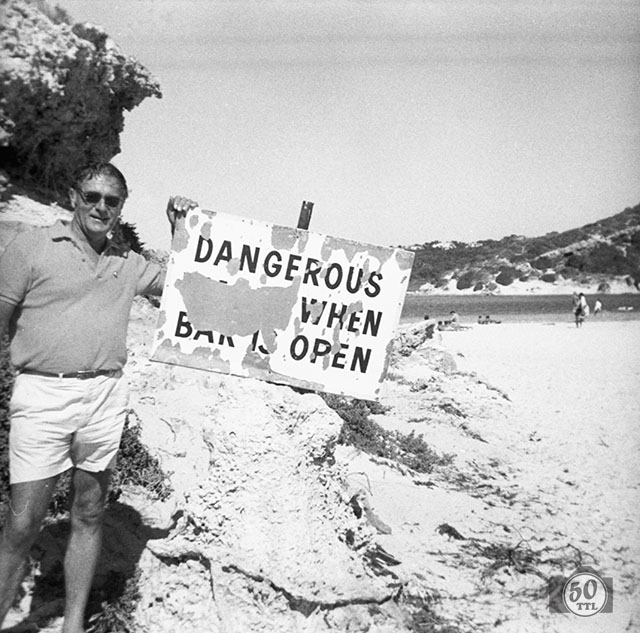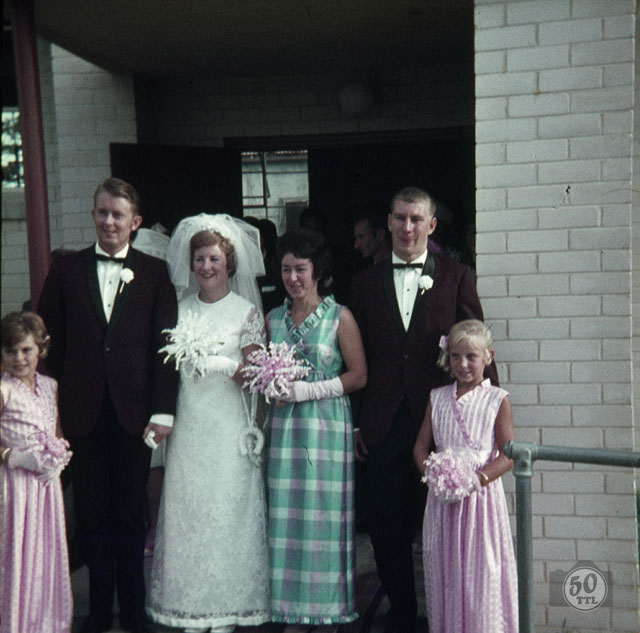
This is my father, who was not actually dangerous when the bar was open, but the sign was irresistible anyway. I think this was taken at Moore River. In case you are confused, the sign refers to the sand bar over the river mouth. It closed over for much of the year, but dangerous currents would form when the river broke through to the sea.
Apart from the memory in the silver grains, a lot of these moments are lost to me. It’s not so much that I remember visiting Moore River when I was 13, it’s more that I associate the name Moore River with the photo. To some degree, my memory is externalised by the fact that I took a photo.
Some people worry about the extent to which digital photos and social media records are externalising the memories of a generation, so that if it wasn’t photographed, it didn’t happen. I’m not so concerned. People’s memories have always varied. Some people from former generations externalised their memories by writing journals or letters. The digital generation comprises the same mix of mental abilities as every generation before it, and you can bet that if the mental capacity of a generation is not being used in the same way for memory, it is being used for something else. For many the ‘something else’ is likely to be very constructive in the long term. For some, the freed-up mental capacity will be frittered away. It was always thus.
I am not sure exactly when some of these photos were taken, so a few entries in this series will cover a couple of years. There were no date stamps on my basic camera, but as you will soon see, I added my own form of metadata after a couple of years. Very likely the film stayed in the camera for quite some time before I could afford to have it processed.

Nevertheless, I could somehow afford to buy a roll of colour slide film to photograph my aunt’s wedding. I am glad I did not become a wedding photographer. I respect plenty of wedding photographers that I know, but I don’t want to be among them. I don’t want the responsibility of committing someone else’s internal image of the one day of their life to a digital image that becomes a printed image that defines that day forever. Maybe I’m afraid that I might photograph it as I see it, and deliver an unforgivable slight.
My aunt, my mother’s sister, is now a grandmother, but in this photo she is a young bride forever, accompanied by my mother on her left as her maid of honour.
Over the years, I have photographed a lot of family milestones. Plenty have gone by with no photos to record them, but ask me what they were and I would not be able to tell you. I can identify this one because I took a photo. Once again, that interplay between photos and memory. In my story of my life, this family milestone now has a stronger claim on existence than other events that went by unphotographed.
The photo also tells a little about the times: look at the dress materials, the bride’s gloves, the hairstyles and the suits. As a photo, there is nothing much to say. It is another photo that seems to show parallax error. Some of the photos that I took at this time show that I was aware of the problem and tried at times to allow for it, but when the moment was fleeting and there was a need to compose and shoot quickly, the error returned.
I was 14 in 1970 and, perhaps about this time, my cousin, a science teacher, showed me how to develop black and white film. I began to form ambitions to acquire a film processing tank and an enlarger. And soon, the parallax error would disappear.
Some of you might ask: What is parallax error? You don’t find it much these days. It’s the slight mismatch of framing that happens when your lens and viewfinder are side by side, or above and below. You might frame your subject nicely in the viewfinder, but the lens is a little bit further over, and sees the subject a little bit differently. It probably doesn’t explain all of the framing errors in my early photos, but it was a factor.
These days you usually compose a photo looking at an image relayed from the digital sensor – what you see on the screen at the back of the camera is what the lens sees. A step up from that, you look into a viewfinder and see a digital image of what the lens sees. In a true single lens reflex camera, you compose the image by looking through the lens itself, by way of a prism and a mirror.
Barbara Temperton
7 May 2018Parallax error … fascinating phrase, fascinating metaphor for memory.